Early Walleye Pioneers Become Fishing Professors
Category: article
Jan 26th, 2010 by OutdoorsFIRST
Modified Jan 26th, 2010 at 12:00 AM
Walleye First
Tournament Series
Everything starts somewhere. Those who jump into the early stages of any venture, and survive, become known as pioneers. Those who perform well soon become the professors and spokesmen. That has occurred in professional walleye tournament angling.
Discussing the start-up of walleye tournaments and the early tours generated some very interesting comments by the guys who have collectively more than 100 first place trophies gathering dust. They shared those decades-old ambitions, dreams and also offered a perspective that the “young-guns” of 2010 will find interesting.
Included in this article are Steve Bissett, Daryl Christensen, Mike McClelland, Gary Parsons, Dan Plautz, Bob Propst, Sr., Ron Seelhoff and Bruce “Doc” Samson.
Steve Bissett, Brainerd, MN: After winning numerous team tournaments, chasing the MWC walleyes and winning on Lake Erie with a PWT record weight in1992, and qualifying for the first seven Championships, Steve said, “Those early years were fun. I learned jigging and cranking from my competitors; it was great camaraderie.”
He was a railroad conductor, and fished on his vacation days, and finally couldn’t squeeze out enough time to do the tour, but still fishes seven events each season. “I think back at those great waters (and new waters for all of us) of those early years. Wow! There was a time on Erie in 12-footers that I didn’t know if I’d make it back, but catching 75 giants that day made it worthwhile.” Electronics went from flashers to units that show everything, and he said, “I was successful because I could cover water and find fish with my flasher. Now the GPS and high-tech units are the biggest change in tournaments.”
When he returned with the Lake Erie winner’s check in his pocket, Steve immediately set to work cranking his favorite lake– Mille Lacs — with lead core. Like Erie, he found the big fish miles from the flats, suspended. Flash forward to 2009, “I boated 2,000 walleyes on cranks from Mille Lacs last season. Many days were 50-fish days, and I put 600 hours on my Verado 200, almost all trolling.” His tip to Mille Lacs trollers, “The slots are on top. The big ones are way out.” Of the 2,000 fish landed, only three pushed over the 28-inch mark. “The lessons learned from competition never go away,” he said.
Daryl Christensen, Montello, WI: Viewed as the philosophical preacher on tour, Daryl said, “Reading gives you knowledge; experience gives you understanding.” He got involved in walleye tournaments after guiding for anything that swam to learn about catching walleyes. With that purpose, he set three goals back in the mid-1980’s:
1. Win some high-level tournaments.
2. Make a decent living.
3. Learn more. “The best way is to compete against the best under all conditions and on different bodies of water,” he said.
“What I hoped for on a personal level was achieved. I fished the Super Pros, Aikens Lake, the Artificial Challenges, Shoot-Outs, Championships. It was fun and rewarding,” he said. During his 20-plus years in the tournament trenches, he said his family never went without. “I could have made a bigger financial success doing something else, but it wouldn’t have been as rewarding,” he said.
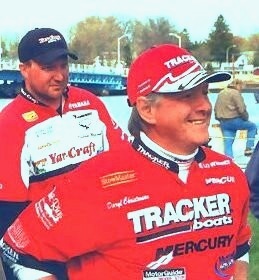 |
|
|
Daryl Christensen
|
Daryl felt the tournament “game” received as much support from the industry as it could have, but lacked the non-industry support. “I had hoped that pro walleye fishing would have grown as big as bass, but after living through it, I don’t think it could have.” Daryl retired from the tour in 2009, and is now very much in demand as a seminar speaker, a respected bird guide and duck hunter.
Mike McClelland, Pierre, SD: If Daryl was the philosopher, Mike was the thinker. He grew up in a boat, and said, “I never went fishing if I didn’t have to.” By that, he meant that as far back as he can remember, he was guiding, and made the progression into tournaments and promotional fishing trips. After fishing the Missouri River competitions in the early 1980’s, he joined the first team tour, winning about everything with partner Bob Propst, Sr. That success continued into the early MWC years. He still holds the record as the only out-of-state winner and the only back-to-back winner of the Merc National in the only two years he fished this prestigious tournament.
And, his office wall proclaims two dozen major tournament victories.
“There is no comparison from the first 10 years of competitive walleye fishing to the last 10,” he said. “We knew absolutely nothing about walleyes – other than we liked to catch them at home.” Tournaments brought minds together. “We couldn’t wait to get to the next new lake and see what the locals would show us or what one of the guys would develop,” he said.
Mike said the rapid advances of gear and equipment played as big a part in growing the walleye movement as did knowledge and tactics. With tougher competition, the spread of knowledge, better equipment, electronics and GPS units, and communications, walleyes took off. “I felt very strongly that by 1995 it had peaked, and by 2000, the end was in sight,” he said of organized competition. Part of that resulted from the limits on growing the market geographically and not gaining new customers every year like happened in those early years. The major advantage today, according to Mike, “Any good student can become a viable competitive tournament walleye angler in three months, and would really be good in a year if he could afford to fish the circuits.” He now operates McClelland’s Steak House and Lounge and catering service in Pierre, while hunting pheasants almost every day of season.
Gary Parsons, Glidden, WI: Looking back, Gary said the landscape’s not much different today than back in the 1980’s. To succeed takes time, money and determination. However, he said, “Instead of rewarding the top pros who’ve earned it, an angler who bought the right product would be in line for tournament contingencies if he did well.” “The full-time, serious guys like Mike Gofron, Tommy Skarlis and me have established good relationships due to repeated success. We have credibility with the public and continue to teach people and impact product sales.”
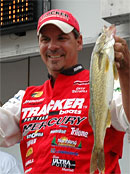 |
|
|
Gary Parsons
|
Always competitive, Gary took up swimming and cross country running in school. “Fishing is sort of like that — size didn’t matter; brains did,” he said. In the first two years of the MWC fishing with his brother, they scored second place in the Team of the Year race, followed by a third the next season. They won tournaments. He learned to jig from Mike McClelland and credits him for his jigging skills today. In 1988, fishing with Keith Kavajecz, they won everything and the Championship. That produced contracts with Daiwa and a $10,000 deal with Jig-A-Whopper. “That’s when Babe Winkelman (then with Lindy) told us we’d crash and burn.”
Instead of flaming-out, Gary invested everything into the fishing business, while at the same time running a 3,500-patient dental practice. He purchased state-of-the-art camera gear, and began sharing ideas and what they were learning on tour with Al and Ron Lindner. “The Lindners were instrumental in my career,” he said. “I thank them all the time.” In 1989 and 1990, Gary said he knew he could make it, despite 55 hours devoted to dentistry and 55 hours to fishing every week. He phased out of the practice in 1998 and has been full-time in the fishing business since.
“I knew with so many walleyes in this part of the country and across Canada that walleye angling would grow,” he said. He felt the sport has a future, much like it did nearly three decades ago. “Companies still need input from tournament anglers. We’re the ones with ideas to make products work better or bring entirely new gear to them,” he said. He challenged anglers to put their money on the table, “Within five or six years spending your own money, and moving through the learning curve, anglers will be able to talk-the-talk.” Gary encouraged young guys to join the NPAA and talk with him directly about fishing or sponsorship. He has branched out to “The Next Bite” website, magazine and TV show, along with seminars and much more.
Dan Plautz, Muskego, WI: Dan started with the MWC, which allowed him to scratch his competitive itch. He and partner Jack Liban fished hard for three days, did the weekend tournament and raced back to home and work. Making the Championships, and then fishing the first PWT, he figured this sport could turn into something.
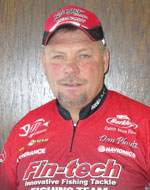 |
|
|
Dan Plautz
|
“This was an adventure and I made the best friends ever,” he said. “I still credit Al and Ron Lindner for putting their resources behind it and hiring the right people to guide it.” The early 1990’s saw interest and sponsorships building, along with new techniques, new lakes, boards, lead core and amazing tactics, he said. He won his first PWT in 1991, which was “super-important.” He’s been on tour and has claimed Championships and lots more titles. “But, I think we’re back to where we started – looking for sponsors. Like then, I knew the walleye-thing could turn into something, and still feel that way despite the nosedive in the economy,” he said. Dan is an owner of AIM, and knows this is the right vision and the way tournaments should be run. However, he said, “I’m not sure where it’s going and very concerned. The costs and lack of individual sponsorships make it almost impossible for new people to get in.”
Bob Propst, Sr., Pierre, SD: Known as the father (maybe grandfather now) of so many walleye tactics, Bob also had one of the best noses in the business for finding fish. From his first tournament at Chamberlain, which he blew out with lead core and cranks to dozens and dozens of top finishes, he said, “The trouble with showing and teaching is that everyone got up to speed with me quickly.”
He was uncanny at stopping on top of fish, often winning tournaments on a whim by stopping at a good-looking spot. He said of long-time friend and early MWC partner Mike McClelland, “He got tired of having me beat him in local tournaments, and finally decided to fish with me.” They tore up the circuits, and also did very well in the pro-am tours later. “I transferred to tournaments what I had experimented with and perfected on the Nebraska reservoirs, like sea anchors, down-riggers, slab spoons and lead core,” he said.
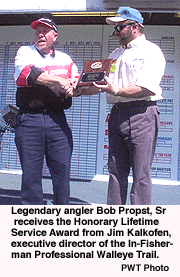 |
|
|
|
It was a thrill to travel to every corner of the country, he said, with stops at the Great Lakes, rivers from New York to Oregon, all the top reservoirs and the best walleyes lakes. “If not in the tournament business, I wouldn’t have done this, but not being a businessman, it would have been nice to have saved a few bucks,” he said. Would he do it again, “Yes,” he said. Today, Bob works with kids and handicapped persons, and also does some guiding, much different than his 1982 calendar which showed 170 days and 150 nights of guiding.
Bruce “Doc” Samson, Minnetrista, MN: Doc went to school for pro fishing by fishing three years with Jerry Anderson. “He was the brains and I was the keeper of bait, but the learning curve was astronomical,” he said. MWC tournament wins, Team of Year titles, a Championship victory and many top finishes poised him for the future. He then jumped into the PWT with no plan, just a goal of competing while on vacation. In 2002, he fished nine tournaments and 18 weekends away from home, while working as doctor. Time was an issue. He won the PWT Devils Lake and the FLW Championship the same year, pocketing $370,000. “With no clue what I was getting into, and wanting to be outside, I jumped into it. I was not a good long-term planner, but got in at the peak when things were growing,” he said. Winning (4 PWTs, MWC success, FLW Championship) made him known to sponsors.
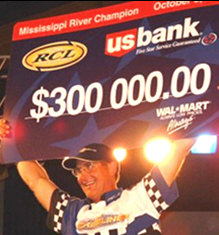 |
|
|
Bruce ‘Doc’ Samson
|
With a talent for teaching, Doc realized that if he taught people to use his sponsor’s products they’d buy more of them. He learned features and benefits, used the gear, and was a master teacher/seller. That led to his modern electronics seminars, respected for being the best anywhere. From the early tournaments, and looking back, Doc said, “Pre-fishing and preparation creates the opportunity to win. I always went for the win, which blew my consistency out the window.” He has a single focus on big fish, which is why he fell in love with the AIM format. “AIM is made for me; I’ll fish ’em all this year. I have it in my mind that I can win in the last hour of the last day.”
“There is no other way to do it than by doing it,” he said of tournaments. Today, he said there is more help, and advised all young pros to join the NPAA and go to the most important meeting of the year – the annual conference – where a young fisherman can learn the ropes. His vision for the future, “I predict tournaments will return as soon as the economy turns around.”
Ron Seelhoff, Burlington, CO: The early tour was a huge learning experience. Ron said, “A few of us did some unique things. We didn’t necessarily invent them; we just made people aware of them. That’s what tournaments do, they help so many average fishermen become better. We were always struggling to find something new to catch fish. There was a ‘big buzz,’ but the excitement has dropped off.”
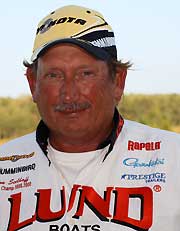 |
|
|
Ron Seelhoff
|
Ron said it was the love of fishing and the thought of making a living that drove him in those early years. “I planned to fish until I couldn’t climb into a boat, but that has come to a screeching halt,” he said. “The worse thing that happened was when the PWT went away. It takes five to 10 years for people to recognize who you are, and with minimal media opportunities, that’s not occurring like it did.” With six PWT wins, two back-to-back Championship victories (only person to ever do that), five seconds and a total of 23 top 10 finishes, people noticed him.
To fish a tour requires money, and sponsorship funding is mostly in the past, but he intends to fish some AIM events and do some guiding, but will cut back his fishing in 2010. “I will get back in the airplane (he’s a crop duster), basically what I would have done if I ever retired from fishing. I have no regrets that made me rich in a lot of ways,” he said.
Author’s Note: These icons of the industry invested their lives and learned their skills in the trenches of the early tournament circuits. Many still compete and are respected as the veterans they are. Salute them when you cross their paths, and thank them for their service.